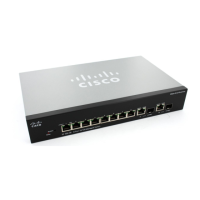Configuring Security
802.1X
Cisco Small Business 300 Series Managed Switch Administration Guide 221
16
To define 802.1X advanced settings for ports:
STEP 1 Click Security > 802.1X > Host and Session Authentication. The Host and
Session Authentication Page displays.
802.1X authentication parameters are described for all ports. All fields except the
following are described in the
Edit Host and Session Authentication Page
.
• Status—Displays the host status. An asterisk indicates that the port is either
not linked or is down. The options are:
- Unauthorized—Either the port control is Force Unauthorized and the
port link is down, or the port control is Auto but a client has not been
authenticated via the port.
- Force-Authorized—Clients have full port access.
- Single-host Lock—Port control is Auto and only a single client has been
authenticated by using the port.
- Multiple Hosts—Port control is Auto and Multiple Hosts mode is enabled.
At least one client has been authenticated.
- Multiple Sessions—Port control is Auto and Multiple Sessions mode is
enabled. At least one session has been authenticated.
- Not in Auto Mode—Auto port control is not enabled.
• Number of Violations—Displays the number of packets that arrive on the
interface in single-host mode, from a host whose MAC address is not the
supplicant MAC address.
STEP 2 Select a port, and click Edit. The Edit Host and Session Authentication Page
displays.
STEP 3 Enter the parameters.
• Port—Enter a port number for which host authentication is enabled.
• Host Authentication—Select one of the modes described above in
Defining Host and Session Authentication.
• Action on Violation—Select the action to be applied to packets arriving in
Single Session/Single Host mode, from a host whose MAC address is not
the supplicant MAC address. The options are:
- Discard—Discards the packets.
- Forward—Forwards the packets.

